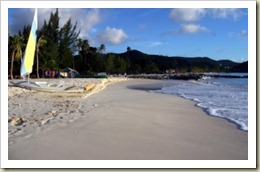Economy
 The main income source for the economy of Antigua and Barbuda is the service area, supported by tourism and services provided by the Government. Over half of GDP is directly or indirectly due to tourism, which is also the main provider of foreign exchange. The touristic influx was seriously diminished after 1995, due to the damages provoked by a series of hurricanes. An important economical sector, the offshore finance, was also affected when, in 1999, the United Kingdom and the United States imposed financial sanctions because of a loosening of the Government’s control over money laundry. Measures were taken to comply with the demands so that the sanctions were lifted.
The main income source for the economy of Antigua and Barbuda is the service area, supported by tourism and services provided by the Government. Over half of GDP is directly or indirectly due to tourism, which is also the main provider of foreign exchange. The touristic influx was seriously diminished after 1995, due to the damages provoked by a series of hurricanes. An important economical sector, the offshore finance, was also affected when, in 1999, the United Kingdom and the United States imposed financial sanctions because of a loosening of the Government’s control over money laundry. Measures were taken to comply with the demands so that the sanctions were lifted.
The agriculture on the sister islands is producing food for domestic use mainly. The water supply is an important restriction in the agricultural development, as well as the lack of labor force, which is more oriented towards tourism and construction. The manufacturing sector produces goods for export, most of them being handicrafts, bedding or electronic components.
The future economic growth of the nation of Antigua and Barbuda depends very much on the number of tourists to come. This, in its turn, depends on the development of industrialized countries, mainly US, which provides almost on third of the tourists. For 2000, the prediction of economic growth was of 2.5%. In 2000 the Inflation was estimated to nearly 0 percent, descending from more than 2 percent between 1995 and 1999.
Because Antigua is so vulnerable to natural disasters, the nation began to diversify its economy, so communications, transportations and many financial services were put an emphasis on.
The currency of Antigua is the East Caribbean Dollar, as the nation belongs to ECCU, the Eastern Caribbean Currency Union. The currency is issued by the Eastern Caribbean Central Bank, or ECCB. The same bank supervises, regulates and manages all the activities regarding commercial banking within the Union.